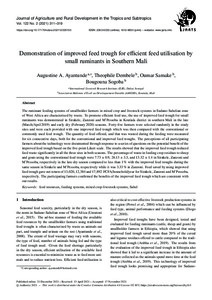| dc.date.accessioned | 2021-12-21T15:54:17Z | |
| dc.date.available | 2021-12-21T15:54:17Z | |
| dc.date.issued | 2021-12-21 | |
| dc.identifier | doi:10.17170/kobra-202112035150 | |
| dc.identifier.uri | http://hdl.handle.net/123456789/13452 | |
| dc.language.iso | eng | eng |
| dc.rights | Namensnennung 4.0 International | * |
| dc.rights.uri | http://creativecommons.org/licenses/by/4.0/ | * |
| dc.subject | feed resources | eng |
| dc.subject | feeding systems | eng |
| dc.subject | mixed crop-livestock systems | eng |
| dc.subject | Sahel | eng |
| dc.subject.ddc | 630 | |
| dc.title | Demonstration of improved feed trough for efficient feed utilisation by small ruminants in Southern Mali | eng |
| dc.type | Aufsatz | |
| dcterms.abstract | The ruminant feeding systems of smallholder farmers in mixed crop and livestock systems in Sudano-Sahelian zone of West Africa are characterised by waste. To promote efficient feed use, the use of improved feed trough for small ruminants was demonstrated in Sirakele, Zanzoni and M’Pessoba in Koutiala district in southern Mali in the late (March/April 2019) and early dry (February 2020) seasons. Forty-five farmers were selected randomly in the study sites and were each provided with one improved feed trough which was then compared with the conventional or commonly used feed trough. The quantity of feed offered, and that was wasted during the feeding were measured for six consecutive days, both for the conventional and improved feed troughs. The perceptions of all participating farmers about the technology were documented through response to a series of questions on the potential benefit of the improved feed trough based on the five-point Likert scale. The results showed that the improved feed trough reduced feed waste significantly in all the three sites in both seasons. The percentage of waste in feeding crop residues to sheep and goats using the conventional feed trough were 7.73 ± 0.9, 26.13 ± 3.3, and 13.32 ± 1.4 in Sirakele, Zanzoni and M’Pessoba, respectively in the late dry season compared to less than 1% with the improved feed troughs during the same season in Sirakele and M’Pessoba, respectively while it was 3.33% in Zanzoni. Feed saved by using improved feed trough gave net return of 13,020, 12,384 and 17,892 FCFA/household/year for Sirakele, Zanzoni and M’Pessoba, respectively. The participating farmers confirmed the benefits of the improved feed trough which are consistent with our results. | eng |
| dcterms.accessRights | open access | |
| dcterms.creator | Ayantunde, Augustine Abioye | |
| dcterms.creator | Dembele, Theophile | |
| dcterms.creator | Samake, Oumar | |
| dcterms.creator | Sogoba, Bougouna | |
| dc.subject.swd | Mali (Süd) | ger |
| dc.subject.swd | Sahel | ger |
| dc.subject.swd | Kleinbauer | ger |
| dc.subject.swd | Futtermittel | ger |
| dc.subject.swd | Fütterung | ger |
| dc.subject.swd | Ressourceneffizienz | ger |
| dc.subject.swd | Wiederkäuer | ger |
| dc.type.version | publishedVersion | |
| dcterms.source.identifier | eissn:2363-6033 | |
| dcterms.source.issue | No. 2 | |
| dcterms.source.journal | Journal of Agriculture and Rural Development in the Tropics and Subtropics (JARTS) | eng |
| dcterms.source.pageinfo | 311-319 | |
| dcterms.source.volume | Vol. 122 | |
| kup.iskup | false | |


